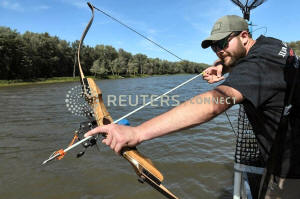Bow hunters target invasive Asian carp for sport on the Illinois River
 Send a link to a friend
Send a link to a friend
 [September 20, 2019]
By Nick Pfosi [September 20, 2019]
By Nick Pfosi
PEORIA, Ill. (Reuters) - A firefighter and
archery enthusiast is making some extra cash with a novel if modest
contribution to the ecosystem of the Great Lakes - taking paying
customers out for boat rides on the Illinois River to hunt invasive
Asian carp fish with bows and arrows.
Nathan Wallick, better known as Captain Nate to his Peoria Carp Hunters
clientele, is one of several private operators capitalizing on a
bowfishing craze that helps to keep the carp - voracious, prolific
aquatic pests - out of the largest freshwater lakes in the United
States.
As he pilots his specially outfitted boat along the Illinois River about
100 miles (160 km) downstream from Lake Michigan, Wallick's patrons test
their archery skills shooting at carp with harpoon-like arrows as the
silvery, muscular fish leap several feet out of the water in the
vessel's wake.

Wallick, 35, a professional firefighter with a love of hunting and
angling, distinguishes this brand of "aerial bowfishing" from more
traditional methods by which archers ply the river at night with
spotlights, hunting for carp swimming beneath the surface.
At the end of a daylong outing last Saturday with six of his regular
customers, Wallick's vessel returned with a barrel of about 100 carp
skewered in mid-air and reeled into the boat.
"The name of the game is try and knock them down as much as possible and
keep them from getting into the Great Lakes," Wallick told Reuters in an
interview.
PROLIFIC INVADERS
Their catch pales in comparison to the numbers taken annually by
commercial fishing boats working under contract for the Illinois
Department of Natural Resources.
That effort has removed 8.5 million pounds (3.9 million kg)of Asian carp
from the upper Illinois River alone since it began in 2010, according to
Kevin Irons, the department's aquatic nuisance program manager.
Although the carp are tasty and considered a delicacy in China, the ones
caught in removal operations are supplied to vendors who process them
into non-food products such as fish oil, fertilizer and pet treats,
Irons said.
[to top of second column]
|

Zach VandeVusse, 23, an electrician from Hamilton Michigan, lines up
a shot on Captain Nate Wallick's boat while out hunting Asian carp
with bow and arrow, on the Illinois River near Lacon, Illinois,
U.S., September 14, 2019. REUTERS/Nicholas Pfosi

The agency welcomes the relatively small added contribution from
sport bowfishing, he said.
So far, Lake Michigan and three of the five other Great Lakes -
Superior, Huron and Ontario - remain free of Asian carp, Irons said.
Just two carp have ever been detected in the Illinois Waterway - a
shipping channel linking Lake Michigan to the Illinois River -
beyond an electric barrier designed to keep them out. Both were
caught.
Still, scientists remain vigilant.
Four Asian carp species now inhabit much of the Mississippi River
watershed that drains a large swath of the United States, while one
species, grass carp, has made it into one of the Great Lakes, Lake
Erie.
The prodigious Asian carp, which can grow to 100 pounds feeding
entirely on plankton, threaten to upset food chains of the waterways
they inhabit while crowding out native fish. In the lower Illinois
River, for instance, they now account for 70% of the aquatic life,
Irons said.
Originating from China, Asian carp were deliberately introduced into
the United States in the 1970s to help control plankton blooms in
commercial catfish ponds in the South. But through flooding and
accidental releases, the carp found their way into the Mississippi
and have invaded many of the nation's rivers and streams since.
(Reporting by Nick Pfosi in Peoria, Illinois; Writing and additional
reporting by Steve Gorman in Los Angeles; Editing by Rosalba
O'Brien)
[© 2019 Thomson Reuters. All rights
reserved.]
Copyright 2019 Reuters. All rights reserved. This material may not be published,
broadcast, rewritten or redistributed.
Thompson Reuters is solely responsible for this content.
 |